Tianyu Chen
FRoD: Full-Rank Efficient Fine-Tuning with Rotational Degrees for Fast Convergence
Dec 29, 2025Abstract:Parameter-efficient fine-tuning (PEFT) methods have emerged as a practical solution for adapting large foundation models to downstream tasks, reducing computational and memory costs by updating only a small subset of parameters. Among them, approaches like LoRA aim to strike a balance between efficiency and expressiveness, but often suffer from slow convergence and limited adaptation capacity due to their inherent low-rank constraints. This trade-off hampers the ability of PEFT methods to capture complex patterns needed for diverse tasks. To address these challenges, we propose FRoD, a novel fine-tuning method that combines hierarchical joint decomposition with rotational degrees of freedom. By extracting a globally shared basis across layers and injecting sparse, learnable perturbations into scaling factors for flexible full-rank updates, FRoD enhances expressiveness and efficiency, leading to faster and more robust convergence. On 20 benchmarks spanning vision, reasoning, and language understanding, FRoD matches full model fine-tuning in accuracy, while using only 1.72% of trainable parameters under identical training budgets.
Towards Long-window Anchoring in Vision-Language Model Distillation
Dec 25, 2025Abstract:While large vision-language models (VLMs) demonstrate strong long-context understanding, their prevalent small branches fail on linguistics-photography alignment for a limited window size. We discover that knowledge distillation improves students' capability as a complement to Rotary Position Embeddings (RoPE) on window sizes (anchored from large models). Building on this insight, we propose LAid, which directly aims at the transfer of long-range attention mechanisms through two complementary components: (1) a progressive distance-weighted attention matching that dynamically emphasizes longer position differences during training, and (2) a learnable RoPE response gain modulation that selectively amplifies position sensitivity where needed. Extensive experiments across multiple model families demonstrate that LAid-distilled models achieve up to 3.2 times longer effective context windows compared to baseline small models, while maintaining or improving performance on standard VL benchmarks. Spectral analysis also suggests that LAid successfully preserves crucial low-frequency attention components that conventional methods fail to transfer. Our work not only provides practical techniques for building more efficient long-context VLMs but also offers theoretical insights into how positional understanding emerges and transfers during distillation.
Sigma-MoE-Tiny Technical Report
Dec 19, 2025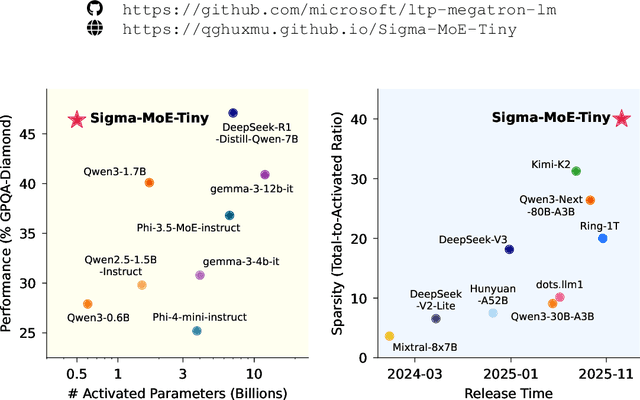
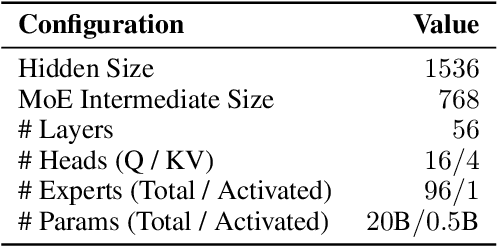
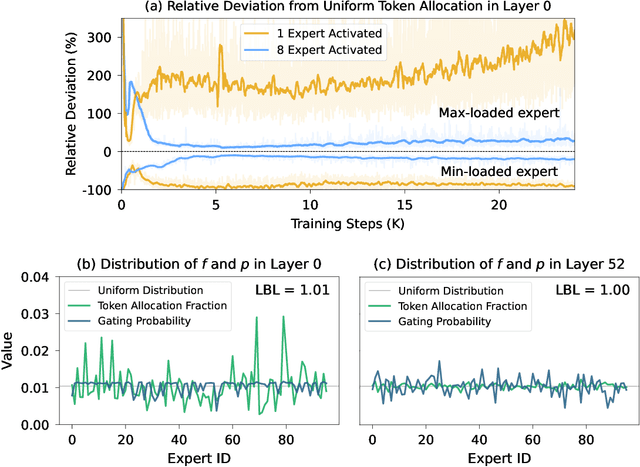
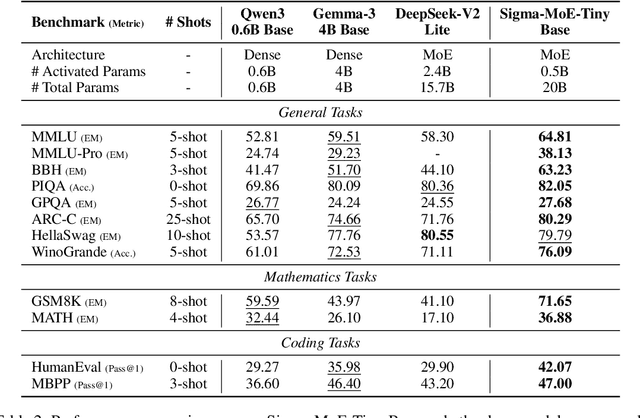
Abstract:Mixture-of-Experts (MoE) has emerged as a promising paradigm for foundation models due to its efficient and powerful scalability. In this work, we present Sigma-MoE-Tiny, an MoE language model that achieves the highest sparsity compared to existing open-source models. Sigma-MoE-Tiny employs fine-grained expert segmentation with up to 96 experts per layer, while activating only one expert for each token, resulting in 20B total parameters with just 0.5B activated. The major challenge introduced by such extreme sparsity lies in expert load balancing. We find that the widely-used load balancing loss tends to become ineffective in the lower layers under this setting. To address this issue, we propose a progressive sparsification schedule aiming to balance expert utilization and training stability. Sigma-MoE-Tiny is pre-trained on a diverse and high-quality corpus, followed by post-training to further unlock its capabilities. The entire training process remains remarkably stable, with no occurrence of irrecoverable loss spikes. Comprehensive evaluations reveal that, despite activating only 0.5B parameters, Sigma-MoE-Tiny achieves top-tier performance among counterparts of comparable or significantly larger scale. In addition, we provide an in-depth discussion of load balancing in highly sparse MoE models, offering insights for advancing sparsity in future MoE architectures. Project page: https://qghuxmu.github.io/Sigma-MoE-Tiny Code: https://github.com/microsoft/ltp-megatron-lm
SIGMA: An AI-Empowered Training Stack on Early-Life Hardware
Dec 15, 2025Abstract:An increasing variety of AI accelerators is being considered for large-scale training. However, enabling large-scale training on early-life AI accelerators faces three core challenges: frequent system disruptions and undefined failure modes that undermine reliability; numerical errors and training instabilities that threaten correctness and convergence; and the complexity of parallelism optimization combined with unpredictable local noise that degrades efficiency. To address these challenges, SIGMA is an open-source training stack designed to improve the reliability, stability, and efficiency of large-scale distributed training on early-life AI hardware. The core of this initiative is the LUCIA TRAINING PLATFORM (LTP), the system optimized for clusters with early-life AI accelerators. Since its launch in March 2025, LTP has significantly enhanced training reliability and operational productivity. Over the past five months, it has achieved an impressive 94.45% effective cluster accelerator utilization, while also substantially reducing node recycling and job-recovery times. Building on the foundation of LTP, the LUCIA TRAINING FRAMEWORK (LTF) successfully trained SIGMA-MOE, a 200B MoE model, using 2,048 AI accelerators. This effort delivered remarkable stability and efficiency outcomes, achieving 21.08% MFU, state-of-the-art downstream accuracy, and encountering only one stability incident over a 75-day period. Together, these advances establish SIGMA, which not only tackles the critical challenges of large-scale training but also establishes a new benchmark for AI infrastructure and platform innovation, offering a robust, cost-effective alternative to prevailing established accelerator stacks and significantly advancing AI capabilities and scalability. The source code of SIGMA is available at https://github.com/microsoft/LuciaTrainingPlatform.
Fine-Tuned LLMs Know They Don't Know: A Parameter-Efficient Approach to Recovering Honesty
Nov 17, 2025Abstract:The honesty of Large Language Models (LLMs) is increasingly important for safe deployment in high-stakes domains. However, this crucial trait is severely undermined by supervised fine-tuning (SFT), a common technique for model specialization. Existing recovery methods rely on data-intensive global parameter adjustments, implicitly assuming that SFT deeply corrupts the models' ability to recognize their knowledge boundaries. However, we observe that fine-tuned LLMs still preserve this ability; what is damaged is their capacity to faithfully express that awareness. Building on this, we propose Honesty-Critical Neurons Restoration (HCNR) to surgically repair this suppressed capacity. HCNR identifies and restores key expression-governing neurons to their pre-trained state while harmonizing them with task-oriented neurons via Hessian-guided compensation. Experiments on four QA tasks and five LLM families demonstrate that HCNR effectively recovers 33.25% of the compromised honesty while achieving at least 2.23x speedup with over 10x less data compared to baseline methods, offering a practical solution for trustworthy LLM deployment.
CoLT: The conditional localization test for assessing the accuracy of neural posterior estimates
Jul 22, 2025Abstract:We consider the problem of validating whether a neural posterior estimate \( q(\theta \mid x) \) is an accurate approximation to the true, unknown true posterior \( p(\theta \mid x) \). Existing methods for evaluating the quality of an NPE estimate are largely derived from classifier-based tests or divergence measures, but these suffer from several practical drawbacks. As an alternative, we introduce the \emph{Conditional Localization Test} (CoLT), a principled method designed to detect discrepancies between \( p(\theta \mid x) \) and \( q(\theta \mid x) \) across the full range of conditioning inputs. Rather than relying on exhaustive comparisons or density estimation at every \( x \), CoLT learns a localization function that adaptively selects points $\theta_l(x)$ where the neural posterior $q$ deviates most strongly from the true posterior $p$ for that $x$. This approach is particularly advantageous in typical simulation-based inference settings, where only a single draw \( \theta \sim p(\theta \mid x) \) from the true posterior is observed for each conditioning input, but where the neural posterior \( q(\theta \mid x) \) can be sampled an arbitrary number of times. Our theoretical results establish necessary and sufficient conditions for assessing distributional equality across all \( x \), offering both rigorous guarantees and practical scalability. Empirically, we demonstrate that CoLT not only performs better than existing methods at comparing $p$ and $q$, but also pinpoints regions of significant divergence, providing actionable insights for model refinement. These properties position CoLT as a state-of-the-art solution for validating neural posterior estimates.
The surprising strength of weak classifiers for validating neural posterior estimates
Jul 22, 2025Abstract:Neural Posterior Estimation (NPE) has emerged as a powerful approach for amortized Bayesian inference when the true posterior $p(\theta \mid y)$ is intractable or difficult to sample. But evaluating the accuracy of neural posterior estimates remains challenging, with existing methods suffering from major limitations. One appealing and widely used method is the classifier two-sample test (C2ST), where a classifier is trained to distinguish samples from the true posterior $p(\theta \mid y)$ versus the learned NPE approximation $q(\theta \mid y)$. Yet despite the appealing simplicity of the C2ST, its theoretical and practical reliability depend upon having access to a near-Bayes-optimal classifier -- a requirement that is rarely met and, at best, difficult to verify. Thus a major open question is: can a weak classifier still be useful for neural posterior validation? We show that the answer is yes. Building on the work of Hu and Lei, we present several key results for a conformal variant of the C2ST, which converts any trained classifier's scores -- even those of weak or over-fitted models -- into exact finite-sample p-values. We establish two key theoretical properties of the conformal C2ST: (i) finite-sample Type-I error control, and (ii) non-trivial power that degrades gently in tandem with the error of the trained classifier. The upshot is that even weak, biased, or overfit classifiers can still yield powerful and reliable tests. Empirically, the Conformal C2ST outperforms classical discriminative tests across a wide range of benchmarks. These results reveal the under appreciated strength of weak classifiers for validating neural posterior estimates, establishing the conformal C2ST as a practical, theoretically grounded diagnostic for modern simulation-based inference.
Safeguarding Multimodal Knowledge Copyright in the RAG-as-a-Service Environment
Jun 10, 2025Abstract:As Retrieval-Augmented Generation (RAG) evolves into service-oriented platforms (Rag-as-a-Service) with shared knowledge bases, protecting the copyright of contributed data becomes essential. Existing watermarking methods in RAG focus solely on textual knowledge, leaving image knowledge unprotected. In this work, we propose AQUA, the first watermark framework for image knowledge protection in Multimodal RAG systems. AQUA embeds semantic signals into synthetic images using two complementary methods: acronym-based triggers and spatial relationship cues. These techniques ensure watermark signals survive indirect watermark propagation from image retriever to textual generator, being efficient, effective and imperceptible. Experiments across diverse models and datasets show that AQUA enables robust, stealthy, and reliable copyright tracing, filling a key gap in multimodal RAG protection.
Improving Data Efficiency for LLM Reinforcement Fine-tuning Through Difficulty-targeted Online Data Selection and Rollout Replay
Jun 05, 2025Abstract:Reinforcement learning (RL) has become an effective approach for fine-tuning large language models (LLMs), particularly to enhance their reasoning capabilities. However, RL fine-tuning remains highly resource-intensive, and existing work has largely overlooked the problem of data efficiency. In this paper, we propose two techniques to improve data efficiency in LLM RL fine-tuning: difficulty-targeted online data selection and rollout replay. We introduce the notion of adaptive difficulty to guide online data selection, prioritizing questions of moderate difficulty that are more likely to yield informative learning signals. To estimate adaptive difficulty efficiently, we develop an attention-based framework that requires rollouts for only a small reference set of questions. The adaptive difficulty of the remaining questions is then estimated based on their similarity to this set. To further reduce rollout cost, we introduce a rollout replay mechanism that reuses recent rollouts, lowering per-step computation while maintaining stable updates. Extensive experiments across 6 LLM-dataset combinations show that our method reduces RL fine-tuning time by 25% to 65% to reach the same level of performance as the original GRPO algorithm.
Restoration Score Distillation: From Corrupted Diffusion Pretraining to One-Step High-Quality Generation
May 19, 2025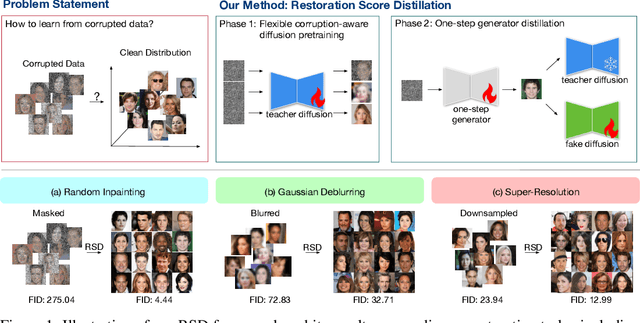



Abstract:Learning generative models from corrupted data is a fundamental yet persistently challenging task across scientific disciplines, particularly when access to clean data is limited or expensive. Denoising Score Distillation (DSD) \cite{chen2025denoising} recently introduced a novel and surprisingly effective strategy that leverages score distillation to train high-fidelity generative models directly from noisy observations. Building upon this foundation, we propose \textit{Restoration Score Distillation} (RSD), a principled generalization of DSD that accommodates a broader range of corruption types, such as blurred, incomplete, or low-resolution images. RSD operates by first pretraining a teacher diffusion model solely on corrupted data and subsequently distilling it into a single-step generator that produces high-quality reconstructions. Empirically, RSD consistently surpasses its teacher model across diverse restoration tasks on both natural and scientific datasets. Moreover, beyond standard diffusion objectives, the RSD framework is compatible with several corruption-aware training techniques such as Ambient Tweedie, Ambient Diffusion, and its Fourier-space variant, enabling flexible integration with recent advances in diffusion modeling. Theoretically, we demonstrate that in a linear regime, RSD recovers the eigenspace of the clean data covariance matrix from linear measurements, thereby serving as an implicit regularizer. This interpretation recasts score distillation not only as a sampling acceleration technique but as a principled approach to enhancing generative performance in severely degraded data regimes.
 Add to Chrome
Add to Chrome Add to Firefox
Add to Firefox Add to Edge
Add to Edge